ASUS TUF Z97 Mark S Motherboard Review: The Arctic Camo Special Edition
by Ian Cutress on November 10, 2014 10:00 AM EST- Posted in
- Motherboards
- Asus
- TUF
- Z97
- Sabertooth
CPU Benchmarks
Readers of our motherboard review section will have noted the trend in modern motherboards to implement a form of MultiCore Enhancement / Acceleration / Turbo (read our report here) on their motherboards. This does several things, including better benchmark results at stock settings (not entirely needed if overclocking is an end-user goal) at the expense of heat and temperature. It also gives in essence an automatic overclock which may be against what the user wants. Our testing methodology is ‘out-of-the-box’, with the latest public BIOS installed and XMP enabled, and thus subject to the whims of this feature. It is ultimately up to the motherboard manufacturer to take this risk – and manufacturers taking risks in the setup is something they do on every product (think C-state settings, USB priority, DPC Latency / monitoring priority, memory subtimings at JEDEC). Processor speed change is part of that risk, and ultimately if no overclocking is planned, some motherboards will affect how fast that shiny new processor goes and can be an important factor in the system build.
For reference the ASUS TUF Z97 Mark S in our setup, with BIOS 2102, did implement a form of MultiCore Turbo.
Point Calculations – 3D Movement Algorithm Test: link
3DPM is a self-penned benchmark, taking basic 3D movement algorithms used in Brownian Motion simulations and testing them for speed. High floating point performance, MHz and IPC wins in the single thread version, whereas the multithread version has to handle the threads and loves more cores.
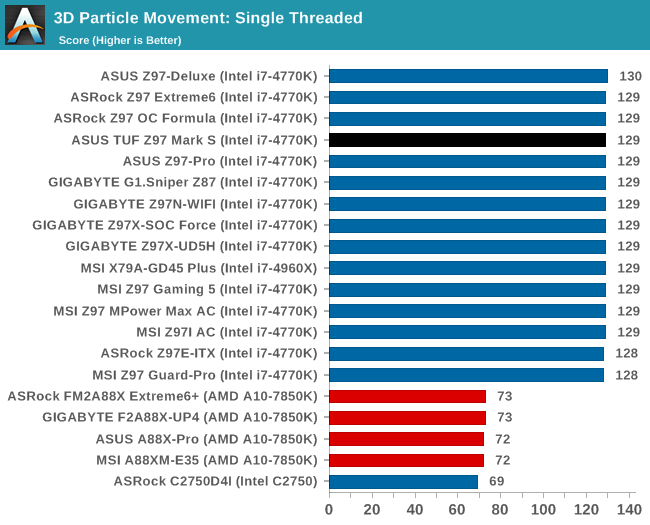
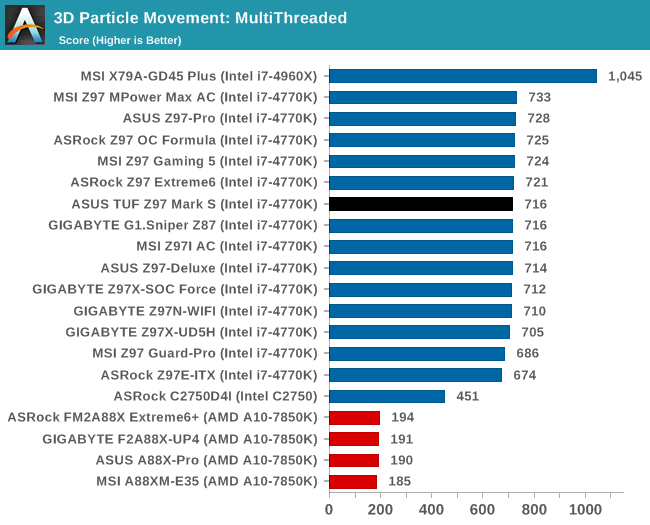
Compression – WinRAR 5.0.1: link
Our WinRAR test from 2013 is updated to the latest version of WinRAR at the start of 2014. We compress a set of 2867 files across 320 folders totaling 1.52 GB in size – 95% of these files are small typical website files, and the rest (90% of the size) are small 30 second 720p videos.
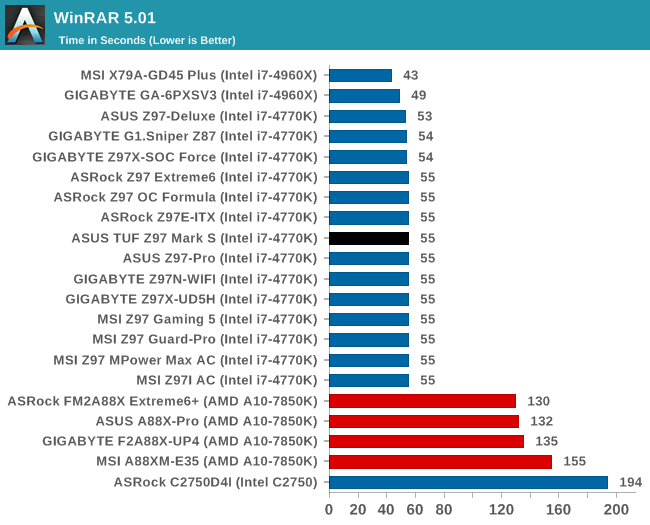
Image Manipulation – FastStone Image Viewer 4.9: link
Similarly to WinRAR, the FastStone test us updated for 2014 to the latest version. FastStone is the program I use to perform quick or bulk actions on images, such as resizing, adjusting for color and cropping. In our test we take a series of 170 images in various sizes and formats and convert them all into 640x480 .gif files, maintaining the aspect ratio. FastStone does not use multithreading for this test, and thus single threaded performance is often the winner.

Video Conversion – Handbrake v0.9.9: link
Handbrake is a media conversion tool that was initially designed to help DVD ISOs and Video CDs into more common video formats. The principle today is still the same, primarily as an output for H.264 + AAC/MP3 audio within an MKV container. In our test we use the same videos as in the Xilisoft test, and results are given in frames per second.
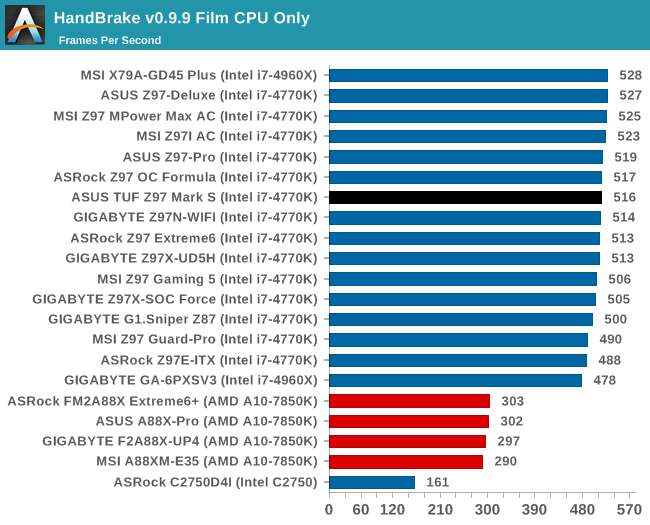

Rendering – PovRay 3.7: link
The Persistence of Vision RayTracer, or PovRay, is a freeware package for as the name suggests, ray tracing. It is a pure renderer, rather than modeling software, but the latest beta version contains a handy benchmark for stressing all processing threads on a platform. We have been using this test in motherboard reviews to test memory stability at various CPU speeds to good effect – if it passes the test, the IMC in the CPU is stable for a given CPU speed. As a CPU test, it runs for approximately 2-3 minutes on high end platforms.
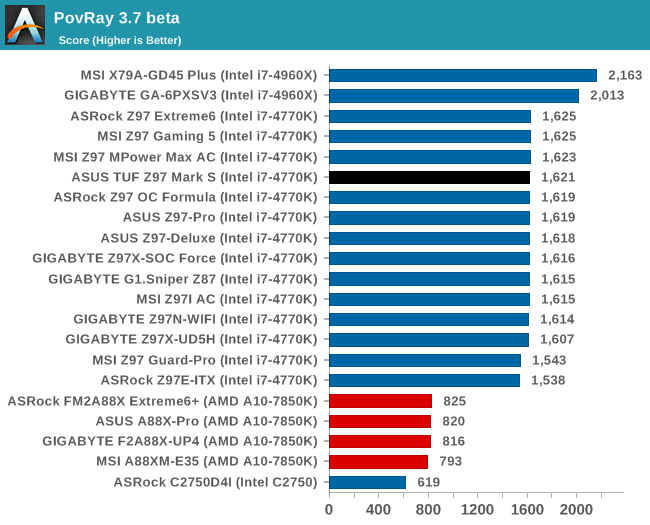
Synthetic – 7-Zip 9.2: link
As an open source compression tool, 7-Zip is a popular tool for making sets of files easier to handle and transfer. The software offers up its own benchmark, to which we report the result.
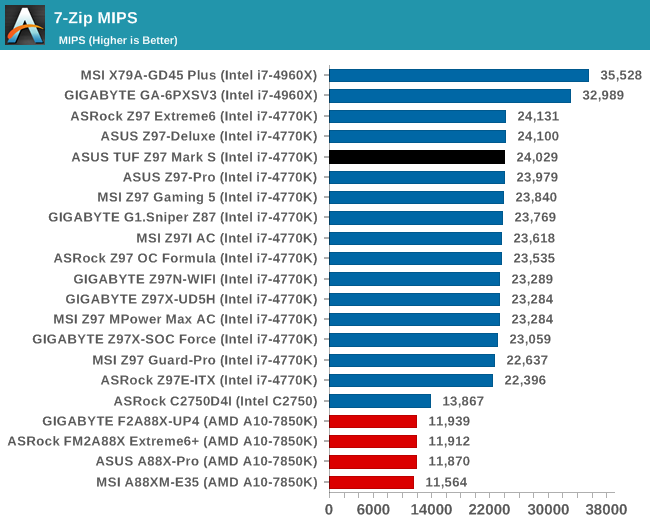










45 Comments
View All Comments
Pontius Dilate - Monday, November 10, 2014 - link
I really would have liked to see pictures of the board with the armor removed. The white PCB sounds like it could be interesting by itself.xthetenth - Monday, November 10, 2014 - link
Yeah, I'd be really interested in how it looks with just the white board, especially since it seems the thermal armor is removable. I think that'd look extra cool in a white case.futurepastnow - Monday, November 10, 2014 - link
Cheap, stupid looking plastic and cheap, stupid looking fans, neither of which serve any purpose. Looks like a winner.JaredNihilist - Monday, November 10, 2014 - link
Have the Z77 Sabertooth. Board fans still working fine and don't notice any extra noise from them. Albeit, I don't notice any benefit from them either, heat-wise - I'm sure they've stopped their fair share of dust.I didn't mind paying the extra for appearance though, I liked that it hid the rest of the board. I found the build the same as others, armour didn't impede anything. Once I upgrade though, shall definitely be removing the armour to customise its look - too scared to do it at the moment as my mainstay PC.
mexell - Monday, November 10, 2014 - link
What a colossal waste of money. However, to each his (or her) own, I suppose.nekoken - Monday, November 10, 2014 - link
I'm pretty dubious about the thermal armor, and its efficacy. I have the Sabertooth 55i and Sabertooth 990FX motherboards and have been quite happy with them. They work quite well in a wide temperature range without that plastic wrap.I'm more than dubious about a modern motherboard that has two different on motherboard fans. I don't ever plan on owning another system that needs an active cooling solution for the stuff built into the motherboard (other than SoC systems.)
xthetenth - Monday, November 10, 2014 - link
Is there any word on whether they'll release one without the thermal armor?Miqunator - Tuesday, November 11, 2014 - link
There is the Z97 mark 2 board that doesn't have the armor, haven't bothered to compare the other features so not sure if you lose something else too.xthetenth - Tuesday, November 11, 2014 - link
I'm hoping they'll do something like the mark 2 with the S coloring, because a white PCB looks super cool and they're promising it'll actually stay white. IIRC the 2 only misses out on an ethernet port and a significant fraction of the cost.CrazyElf - Monday, November 10, 2014 - link
The back might be worth something. It it will serve as a function similar to those GPU backplates, preventing warping from heavy CPU coolers and perhaps triple slot GPUs as well. Gimmicky, but potentially useful in that regard.As far as the front side, it's mostly pointless and maybe harmful (ex: the components may be cooler with the cover off). Dust I suppose, but if you have a DataVac, then this is pointless too. The only protection it might offer is if your screwdriver slips. It also will make removing GPUs a bit of a pain.
The rest of the board I think is underwhelming for the price. At $300, I expect very high end VRMs and a PLX chip.